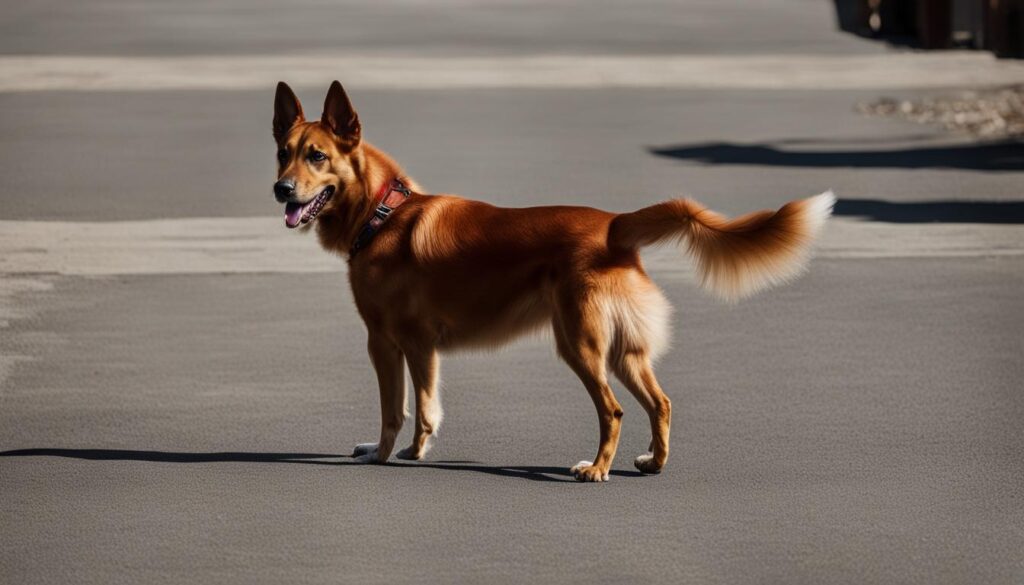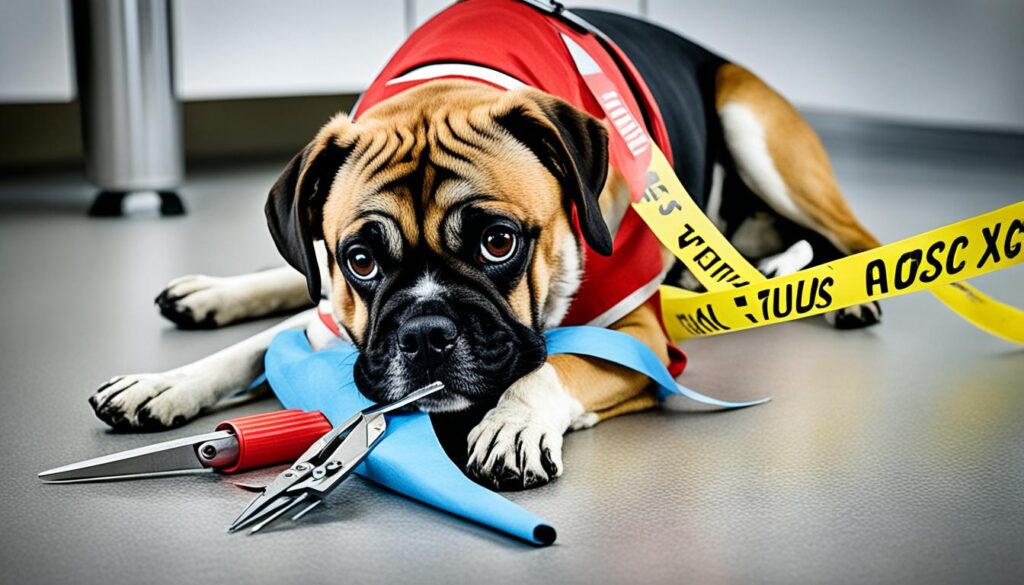Dog Anus Issues: Red, Swollen & Itchy – Causes
A red, swollen, and itchy anus in dogs can be a distressing issue. Just like humans, dogs can experience discomfort and irritation in this sensitive area. It is important to understand the causes behind these symptoms and seek veterinary care for a proper diagnosis and treatment.
Anal itching in dogs can be caused by various factors. It may be a result of anal gland inflammation or infection, which can lead to redness, swelling, and itchiness. Other potential causes include allergies, skin infections, and tumors. Identifying the underlying cause is crucial in providing the appropriate treatment and relief for your furry friend.
If you notice your dog displaying signs of an irritated anus, such as frequent licking, scooting, or biting at the area, it is essential to consult a veterinarian. They will conduct a thorough examination to assess the severity of the condition and determine the possible causes.
The veterinarian may perform tests such as anal gland checks, skin scraping, swabbing, fecal testing, imaging, and allergy testing to further investigate the issue. This comprehensive evaluation will help in devising an effective treatment plan tailored to your dog’s specific needs.
Key Takeaways:
- Red, swollen, and itchy anus in dogs can be caused by various factors, including anal gland inflammation or infection, allergies, skin infections, and tumors.
- Consulting a veterinarian is crucial for a proper diagnosis and treatment plan.
- A comprehensive examination, including tests such as anal gland checks and allergy testing, may be performed by the veterinarian to determine the underlying cause.
- Treatment options can include medication, dietary changes, and in severe cases, surgical removal of the anal glands.
- Early detection and prompt veterinary care are essential in ensuring the well-being of your furry friend.
Understanding Anal Sac Disease in Dogs
Dogs have anal sacs located at the four o’clock and eight o’clock positions near the anus. These sacs contain glands that produce a foul-smelling fluid. The fluid is released through a duct and acts as a territorial marker for dogs. It may also help with the lubrication of feces during elimination.
Anal sac disease is a common condition in dogs. It can be caused by various factors, including impacted anal sacs, anal sac abscess, and anal sac cancer. Symptoms of anal sac disease can include:
- Scooting or dragging the rear end
- Excessive licking or biting of the anal area
- Presence of blood or pus draining from the rectum
When a dog exhibits these symptoms, it is important to consult a veterinarian for proper diagnosis and treatment. The veterinarian will perform a physical examination to check for swelling, skin irritations, and other signs of anal sac disease. Additional tests such as anal sac expression, imaging, and biopsy may be conducted to determine the underlying cause.
Treatment options for anal sac issues can vary depending on the severity and cause of the disease. They may include:
- Expression of the anal sacs to relieve impaction
- Administration of antibiotics to treat infection
- Application of warm compresses to reduce inflammation
- Surgical removal of the anal sacs in severe cases
Regular check-ups with a veterinarian are recommended to prevent recurrence of anal sac disease and to monitor for anal sac cancer, which is a rare but serious condition.
Causes and Treatment of Itchy Bottoms in Dogs
Itchy bottoms in dogs can be attributed to various factors, including fleas, worms, anal gland issues, allergies, skin infections, and tumors. It is crucial to conduct a thorough examination to rule out flea and worm infestations as potential causes. Anal glands, responsible for producing a foul-smelling fluid, may become impacted or infected, resulting in pain and inflammation.
When it comes to treatment options for anal gland problems, there are several approaches to consider. Expressing the glands, either manually or with the help of a veterinarian, can alleviate discomfort. Additionally, infusing antibiotics may be necessary to eliminate any infection present. In severe cases, surgical removal of the anal glands might be recommended.
Prevention is key in managing and minimizing itchy bottoms in dogs. Regular worming and flea treatment play a fundamental role in preventing infestations and potential associated itching. Furthermore, maintaining a healthy weight and activity level can help enhance overall well-being and minimize the risk of anal gland issues.
It’s important for dog owners to be vigilant and seek veterinary care at the first sign of discomfort. A knowledgeable veterinarian can provide guidance on preventive measures and suggest appropriate treatments tailored to each dog’s specific needs.
Common Causes of Itchy Bottoms in Dogs:
- Fleas and worms
- Anal gland issues
- Allergies
- Skin infections
- Tumors
Preventive Measures for Itchy Bottoms in Dogs:
- Regular worming and flea treatment
- Maintaining a healthy weight and activity level
- Seeking veterinary care at the first sign of discomfort
By taking proactive measures and promptly addressing any concerns related to itchy bottoms in dogs, pet owners can ensure their furry companions maintain optimal comfort and well-being.

Surgical Removal of the Anal Glands
In some cases, the surgical removal of the anal glands may be recommended to provide relief from chronic or recurrent anal sac issues. Although this procedure can be effective, it is essential to consider the potential risks and consult with a board-certified veterinary surgeon.
The purpose of the anal glands primarily revolves around territorial marking, and their removal does not adversely affect the overall well-being of the dog. The procedure involves delicate surgical techniques to eliminate the anal glands, providing a long-term solution to persistent anal sac issues.
Risks of Anal Sac Removal
While surgical removal of the anal glands can offer relief, it is important to understand the risks associated with the procedure. Although these risks are relatively rare, they should be considered before making a decision:
- Fecal Incontinence: In some rare cases, there may be temporary or permanent damage to the nerves controlling bowel control, resulting in fecal incontinence. This means the dog may have difficulty controlling and holding their bowel movements.
- Unnecessary Behavior: Dogs instinctively perform anal gland expression as part of their grooming routine. With the removal of the anal glands, this behavior becomes unnecessary. Some dogs may continue to exhibit this behavior even after the surgery due to learned habits.
“The surgical removal of the anal glands can provide long-term relief, but it is crucial to weigh the potential risks, consult with a board-certified veterinary surgeon, and consider the individual needs and circumstances of your pet.”
It is important to discuss the risks, benefits, and alternative treatment options with a qualified veterinarian, who can evaluate the specific case and make an informed recommendation.
Understanding the Purpose of Anal Glands
The anal glands in dogs serve primarily as a means of territorial marking. These small sacs are located on either side of the anus and secrete a distinctive scent that can help dogs communicate with each other and establish their presence in their surroundings.
While the anal glands have a purpose in the natural behavior of dogs, their removal does not have any adverse medical effects on the animal. It is essential to note that anal gland issues can be effectively managed with alternative treatments, such as regular expression or medical interventions, which can be discussed with a veterinarian.

The surgical removal of the anal glands should only be considered when other treatment options have been exhausted or deemed ineffective. It is always advisable to consult with a qualified veterinarian who can provide a comprehensive evaluation and recommendation tailored to the individual needs of your pet.
| Risks | Prevalence | Management |
|---|---|---|
| Fecal Incontinence | Rare | Close post-operative monitoring; potential for medical interventions to manage the condition. |
| Unnecessary Behavior | Varies | Reinforcement of alternative grooming behaviors; training techniques to redirect behavior if necessary. |
Preventing Itchy Bottoms in Dogs
Prevention is key in managing itchy bottoms in dogs. By implementing the following preventive measures, you can help keep your furry friend comfortable and reduce the risk of anal gland issues:
- Regular worming and flea treatment using safe and effective veterinary products.
- Ensure your dog’s anal glands are regularly expressed to prevent impaction and infection.
- Incorporate a high-fiber diet into your dog’s meal plan. This may aid in natural emptying of the anal glands, although its effectiveness is debated.
- Maintain your dog’s muscle tone and overall health through regular exercise. Physical activity can help dogs naturally release anal gland secretions.
It’s important to stay vigilant and observe any signs of discomfort exhibited by your dog, such as dragging the rear end or persistent licking. If you notice these symptoms, it’s crucial to seek prompt veterinary care to identify and address any underlying issues. By taking preventive measures and prioritizing your dog’s health, you can help prevent itchy bottoms and ensure your furry friend leads a happy and comfortable life.
Preventive Measures
Regular Worming and Flea Treatment: Use safe and effective veterinary products to prevent infestations and protect your dog from fleas, worms, and other parasites.
Regular Anal Gland Expression: Have your dog’s anal glands expressed regularly by a professional to reduce the risk of impaction and infection.
High-Fiber Diet: Consider feeding your dog a high-fiber diet to promote natural emptying of the anal glands. Discuss with your veterinarian to determine the most suitable diet for your dog’s specific needs.
Maintaining Muscle Tone: Regular exercise and physical activity can help dogs naturally release anal gland secretions. Keep your dog active to maintain muscle tone and overall health.
Remember, preventive measures play a crucial role in managing and preventing itchy bottoms in dogs. By staying proactive and following these recommendations, you can ensure your dog’s comfort and well-being.
Conclusion
Dog anal issues, including redness, swelling, and itchiness, can arise from various causes and require proper veterinary care. It is crucial to seek a veterinarian’s expertise for diagnosis, treatment, and preventive measures to effectively manage and prevent anal gland problems.
Regular check-ups, along with measures such as worming and flea treatment, can help keep dogs comfortable and prevent recurring issues. Additionally, expressing the anal glands and maintaining a healthy lifestyle, including a high-fiber diet and regular exercise, can aid in promoting proper anal gland function and reducing the risk of complications.
Being vigilant about any signs of discomfort, such as scooting or persistent licking, is essential. Timely veterinary care will ensure the well-being of your dog and minimize the impact of anal gland issues on their quality of life. By prioritizing their care and implementing preventive measures, you can help your furry friend lead a happy and comfortable life.
FAQ
Why is my dog’s anus red, swollen, and itchy?
A red, swollen, and itchy anus in dogs can be caused by various conditions. It is important to consult a veterinarian for a proper diagnosis.
What causes red and swollen dog anus?
The causes of red and swollen dog anus can include anal gland issues, allergies, skin infections, and tumors. A thorough examination by a veterinarian is necessary to determine the underlying cause.
How can I treat my dog’s anal itching?
Treatment options for anal itching in dogs can include medication, dietary changes, and, in severe cases, surgical removal of the anal glands. It is important to seek veterinary care for proper diagnosis and treatment.
What is anal sac disease in dogs?
Anal sac disease is a common condition in dogs where the anal sacs become impacted or infected. Symptoms include scooting, excessive licking or biting, and blood or pus draining from the rectum. Treatment options can include expressing the sacs and antibiotics.
Are there risks associated with surgical removal of the anal glands?
Yes, there are potential risks with surgical removal of the anal glands, including temporary bowel control issues and rare cases of permanent fecal incontinence. It is important to consider the expertise of a board-certified veterinary surgeon for this procedure.
How can I prevent itchy bottoms in my dog?
Preventive measures for itchy bottoms in dogs include regular worming and flea treatment, maintaining a healthy weight and activity level, and seeking veterinary care at the first sign of discomfort. Regular anal gland expression can also help reduce the risk of impaction and infection.
What should I do if my dog has anal issues?
If your dog has anal issues, such as redness, swelling, or itching, it is important to seek veterinary care. A proper diagnosis, treatment, and preventive measures are essential for managing and preventing anal gland problems.
What can I do to keep my dog comfortable?
Keeping up with regular check-ups, worming, flea treatment, and anal gland expression can help keep your dog comfortable. Maintaining a healthy lifestyle through a high-fiber diet and regular exercise can also aid in preventing and managing anal issues.
Why is veterinary care important for dog anal issues?
Veterinary care is important for dog anal issues because a proper diagnosis and treatment plan can be established. Regular check-ups can help prevent recurring issues and monitor for any potential underlying health concerns.
What is the purpose of anal glands in dogs?
Anal glands in dogs primarily serve as territorial markers and may assist with feces lubrication. Removal of the anal glands does not adversely affect the dog’s well-being, as they are not essential for their overall health.


